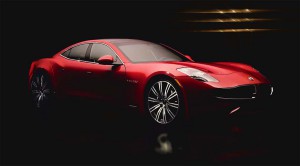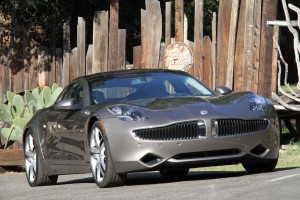
The new Karma Revero retains the same, timeless exterior styling of its predecessor with a few welcome tweaks and can be had for $130,000.
There’ve been plenty of brands that have gone out of production in recent years – think Plymouth, Mercury, Pontiac and Saturn. It’s a rare marque that can come back from the dead, but that’s what happening with Fisker Automotive, the California-based maker of the sexy Karma plug-in hybrid.
All right, that’s not entirely accurate. The Fisker name is gone as the result of a messy 2013 bankruptcy. But the Karma lives on under a new Chinese owner. And to confuse matters a bit, that’s now the name of the company, with the car itself rebadged the Karma Revero.
In its original form, the long-nosed plug-in drew some high-profile, green-minded buyers, including celebrity actor/activist Leonardo DiCaprio. Whether buyers will turn out with cash for the reborn Revero remains to be seen, especially as they’ll be asked to pay $130,000, or 26% more than for the original Karma.
Fisker was just one of a string of electric wannabes, like Aptera, Bright Automotive and Coda, that charged into the market hoping to take advantage of new fuel economy regulations, rising gas prices and substantial government subsidies – both to the start-ups and battery-car buyers. But key government funds dried up, gas prices plunged and, most damning, most of the start-ups were built on financial quicksand, with fatally flawed business models.

The new Revero uses a new high-definition gauge cluster and a new touchscreen. There will be onboard 4G LTE WiFi, and Apple CarPlay is coming.
Despite raising several billion dollars in capital, Fisker Automotive went into bankruptcy less than two years after delivering its first Karma plug-in.
(Old Fisker Karma returns as Karma Revero. Click Here for the story.)
The original model received mixed reviews: highly praised for its design, but faulted for the weaknesses of the range-extender gasoline engine it borrowed from the first-generation Chevrolet Volt.
The good news with the Karma Revero is that it retains the same, timeless exterior styling, with only a few welcome tweaks – and, of course, a new badge. A close inspection reveals subtle changes to the familiar “mustache” grille and the diamond-shaped front air intakes.
There’s also some new technology, no surprise, considering how much has happened on that front since the original Karma sport sedan made its debut. That includes a new high-definition gauge cluster and a new touchscreen. There will be onboard 4G LTE WiFi, and Apple CarPlay is coming, though apparently not on Day One.
As for the drivetrain, there had been plenty of talk about major upgrades, and Jim Taylor, Karma’s chief revenue officer, recently told TheDetroitBureau.com that changes are in the works. What he wouldn’t confirm is that Karma does eventually plan to replace that GM engine with a package it will get from BMW. The German automaker is already providing Karma with some key components, including its updated electrical architecture.

Revero pairs a 260-horsepower turbocharged four cylinder engine with an electric motor drawing power from a lithium-ion battery pack.
Until the German range-extender becomes available – perhaps in a year or so – the Karma Revero will continue to pair that 260-horsepower turbocharged four cylinder engine with an electric motor drawing power from a lithium-ion battery pack. But even so, there have been a few welcome changes made.
The batteries now have a 21.4 kilowatt-hour capacity, one kWh more than before. That boosts EV-mode range to 50 miles. Meanwhile, the Revero shaves a full second off the old Karma’s 0 to 60 launch, now 5.4 seconds. Unfortunately, mileage is expected to remain the same. In normal hybrid mode, expect 20 City, 21 Highway and 20 Combined once EPA certification is completed.
(Karma one of the automakers hoping to tap into China’s push for battery power. Click Here for more.)
Karma has added new DC fast-charging, or Level III, capabilities that should yield an 80% charge-up in under a half-hour. And the on-board charger’s capacity has been doubled, from 3.3 kW to 6.6 kW.
One of the subtle ironies of the Karma revival is that even though the company has a new Chinese owner, the Wanxiang Group, the car itself is now more American than before. Under Fisker, the plug-in was produced by contract manufacturer Valmet in a Finnish plant. Wanxiang has moved the tooling over to a new plant along California’s Orange County coast.
Depending upon who you ask, sales of the original Fisker Karma ran somewhere between 1,000 and 2,000. Many are now sidelined because of a parts shortage. Taylor said the new company will try to salve those owners by getting them parts – and encouraging them to trade in on the new model before other buyers can opt in.
The market is admittedly small, Karma executives telling media during a Thursday briefing that there’s probably a maximum 200,000 to 300,000 customers for the Revero. No surprise considering the $130,000 price tag alone.

The Revero features subtle changes to the familiar “mustache” grille and the diamond-shaped front air intakes from the original Fisker Karma.
(Ironically, another start-up is betting it can tap into a slightly different market. VLF Automotive, a suburban Detroit venture pairing designer Henrik Fisker and former GM Vice Chairman Bob Lutz, are stripping out the hybrid drivetrains from old Karmas, plugging in a 6.2-liter Corvette V-8 and rebadging them the VLF Destino.)
(For more on the Destino and the rest of VLF’s plans, Click Here.)
That’s not a lot of volume to build a company on – especially when you consider that the 22 holdover employees from the old Fisker Automotive have grown to nearly 1,000.
Why so many? Well, while the company isn’t talking much about future plans, it helps to note that three of the concept cars originally developed by Henrik Fisker’s team now have a place of honor at the Karma headquarters in Huntington Beach, California.
One would seem particularly promising now, just as it did four years ago, when the Fisker Atlantic was first revealed. It was intended to do much the same thing as Tesla’s upcoming Model 3, move Fisker more into the mainstream with an affordable plug-in car with incredible good looks. Considering that’s where the battery-car market seems to be heading, one can only imagine those 1,000 employees are quietly working on an update of the Atlantic now that the Karma Revero is back on the road.
